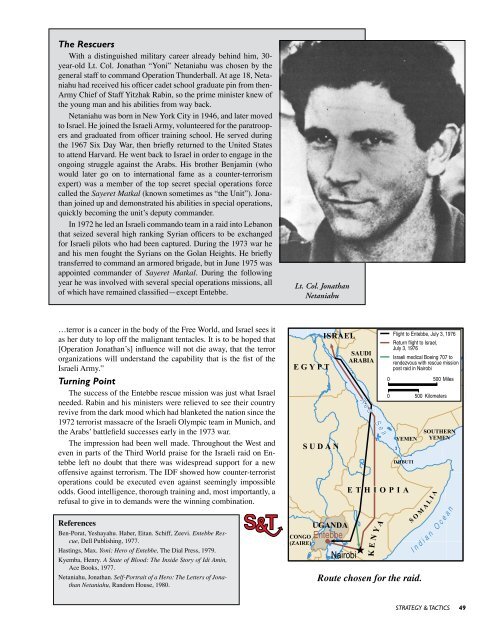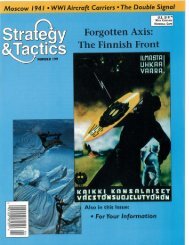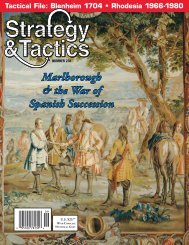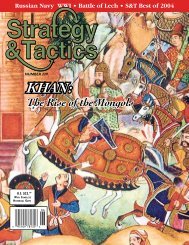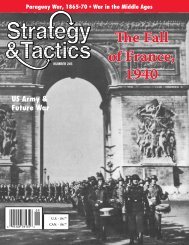COUNTERSTROKE AT SOLTSY - Strategy & Tactics Press
COUNTERSTROKE AT SOLTSY - Strategy & Tactics Press
COUNTERSTROKE AT SOLTSY - Strategy & Tactics Press
Create successful ePaper yourself
Turn your PDF publications into a flip-book with our unique Google optimized e-Paper software.
the rescuers<br />
With a distinguished military career already behind him, 30year-old<br />
Lt. Col. Jonathan “Yoni” Netaniahu was chosen by the<br />
general staff to command Operation Thunderball. At age 18, Netaniahu<br />
had received his officer cadet school graduate pin from then-<br />
Army Chief of Staff Yitzhak Rabin, so the prime minister knew of<br />
the young man and his abilities from way back.<br />
Netaniahu was born in New York City in 1946, and later moved<br />
to Israel. He joined the Israeli Army, volunteered for the paratroopers<br />
and graduated from officer training school. He served during<br />
the 1967 Six Day War, then briefly returned to the United States<br />
to attend Harvard. He went back to Israel in order to engage in the<br />
ongoing struggle against the Arabs. His brother Benjamin (who<br />
would later go on to international fame as a counter-terrorism<br />
expert) was a member of the top secret special operations force<br />
called the Sayeret Matkal (known sometimes as “the Unit”). Jonathan<br />
joined up and demonstrated his abilities in special operations,<br />
quickly becoming the unit’s deputy commander.<br />
In 1972 he led an Israeli commando team in a raid into Lebanon<br />
that seized several high ranking Syrian officers to be exchanged<br />
for Israeli pilots who had been captured. During the 1973 war he<br />
and his men fought the Syrians on the Golan Heights. He briefly<br />
transferred to command an armored brigade, but in June 1975 was<br />
appointed commander of Sayeret Matkal. During the following<br />
year he was involved with several special operations missions, all<br />
of which have remained classified—except Entebbe.<br />
…terror is a cancer in the body of the Free World, and Israel sees it<br />
as her duty to lop off the malignant tentacles. It is to be hoped that<br />
[Operation Jonathan’s] influence will not die away, that the terror<br />
organizations will understand the capability that is the fist of the<br />
Israeli Army.”<br />
turning Point<br />
The success of the Entebbe rescue mission was just what Israel<br />
needed. Rabin and his ministers were relieved to see their country<br />
revive from the dark mood which had blanketed the nation since the<br />
1972 terrorist massacre of the Israeli Olympic team in Munich, and<br />
the Arabs’ battlefield successes early in the 1973 war.<br />
The impression had been well made. Throughout the West and<br />
even in parts of the Third World praise for the Israeli raid on Entebbe<br />
left no doubt that there was widespread support for a new<br />
offensive against terrorism. The IDF showed how counter-terrorist<br />
operations could be executed even against seemingly impossible<br />
odds. Good intelligence, thorough training and, most importantly, a<br />
refusal to give in to demands were the winning combination.<br />
References<br />
Ben-Porat, Yeshayahu. Haber, Eitan. Schiff, Zeevi. Entebbe Rescue,<br />
Dell Publishing, 1977.<br />
Hastings, Max. Yoni: Hero of Entebbe, The Dial <strong>Press</strong>, 1979.<br />
Kyemba, Henry. A State of Blood: The Inside Story of Idi Amin,<br />
Ace Books, 1977.<br />
Netaniahu, Jonathan. Self-Portrait of a Hero: The Letters of Jonathan<br />
Netaniahu, Random House, 1980.<br />
Lt. Col. Jonathan<br />
Netaniahu<br />
Route chosen for the raid.<br />
strategy & tactics 49


